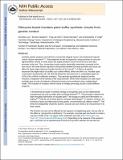| dc.contributor.author | Lou, Chunbo | |
| dc.contributor.author | Stanton, Brynne | |
| dc.contributor.author | Chen, Ying-Ja | |
| dc.contributor.author | Munsky, Brian | |
| dc.contributor.author | Voigt, Christopher A. | |
| dc.date.accessioned | 2014-08-26T16:37:55Z | |
| dc.date.available | 2014-08-26T16:37:55Z | |
| dc.date.issued | 2012-10 | |
| dc.date.submitted | 2012-05 | |
| dc.identifier.issn | 1087-0156 | |
| dc.identifier.issn | 1546-1696 | |
| dc.identifier.uri | http://hdl.handle.net/1721.1/89067 | |
| dc.description.abstract | Synthetic genetic programs are built from circuits that integrate sensors and implement temporal control of gene expression. Transcriptional circuits are layered by using promoters to carry the signal between circuits. In other words, the output promoter of one circuit serves as the input promoter to the next. Thus, connecting circuits requires physically connecting a promoter to the next circuit. We show that the sequence at the junction between the input promoter and circuit can affect the input-output response (transfer function) of the circuit. A library of putative sequences that might reduce (or buffer) such context effects, which we refer to as 'insulator parts', is screened in Escherichia coli. We find that ribozymes that cleave the 5′ untranslated region (5′-UTR) of the mRNA are effective insulators. They generate quantitatively identical transfer functions, irrespective of the identity of the input promoter. When these insulators are used to join synthetic gene circuits, the behavior of layered circuits can be predicted using a mathematical model. The inclusion of insulators will be critical in reliably permuting circuits to build different programs. | en_US |
| dc.description.sponsorship | Life Technologies, Inc. | en_US |
| dc.description.sponsorship | United States. Defense Advanced Research Projects Agency (DARPA CLIO N66001-12-C-4018) | en_US |
| dc.description.sponsorship | United States. Office of Naval Research (N00014-10-1-0245) | en_US |
| dc.description.sponsorship | National Science Foundation (U.S.) (CCF-0943385) | en_US |
| dc.description.sponsorship | National Institutes of Health (U.S.) (AI067699) | en_US |
| dc.description.sponsorship | National Science Foundation (U.S.). Synthetic Biology Engineering Research Center (SynBERC, SA5284-11210) | en_US |
| dc.language.iso | en_US | |
| dc.publisher | Nature Publishing Group | en_US |
| dc.relation.isversionof | http://dx.doi.org/10.1038/nbt.2401 | en_US |
| dc.rights | Article is made available in accordance with the publisher's policy and may be subject to US copyright law. Please refer to the publisher's site for terms of use. | en_US |
| dc.source | PMC | en_US |
| dc.title | Ribozyme-based insulator parts buffer synthetic circuits from genetic context | en_US |
| dc.type | Article | en_US |
| dc.identifier.citation | Lou, Chunbo, Brynne Stanton, Ying-Ja Chen, Brian Munsky, and Christopher A Voigt. “Ribozyme-Based Insulator Parts Buffer Synthetic Circuits from Genetic Context.” Nature Biotechnology 30, no. 11 (October 3, 2012): 1137–1142. | en_US |
| dc.contributor.department | Massachusetts Institute of Technology. Department of Biological Engineering | en_US |
| dc.contributor.department | Massachusetts Institute of Technology. Synthetic Biology Center | en_US |
| dc.contributor.mitauthor | Lou, Chunbo | en_US |
| dc.contributor.mitauthor | Stanton, Brynne | en_US |
| dc.contributor.mitauthor | Chen, Ying-Ja | en_US |
| dc.contributor.mitauthor | Voigt, Christopher A. | en_US |
| dc.relation.journal | Nature Biotechnology | en_US |
| dc.eprint.version | Author's final manuscript | en_US |
| dc.type.uri | http://purl.org/eprint/type/JournalArticle | en_US |
| eprint.status | http://purl.org/eprint/status/PeerReviewed | en_US |
| dspace.orderedauthors | Lou, Chunbo; Stanton, Brynne; Chen, Ying-Ja; Munsky, Brian; Voigt, Christopher A | en_US |
| dc.identifier.orcid | https://orcid.org/0000-0003-0844-4776 | |
| mit.license | PUBLISHER_POLICY | en_US |
| mit.metadata.status | Complete | |
